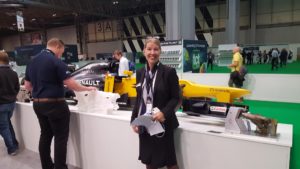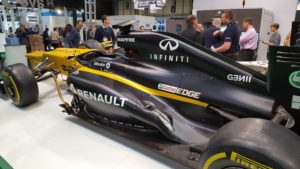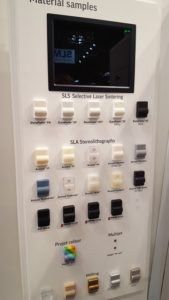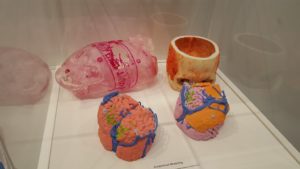 From racing to recreations, and from medical to materials, 3D printing at 3D Systems has never been busier — or broader. During the recent TCT Show in the UK, 3D Systems held court in a complex of a booth, designed as at RAPID earlier this year to showcase the breadth of their activity. As the show itself was built around a variety of vertical markets, the 3D Systems team mirrored this, “demoing what we are doing,” as Nicole Clement, VP of Marketing, Europe, told me as she toured me around the space so I could catch up on the company’s latest.
From racing to recreations, and from medical to materials, 3D printing at 3D Systems has never been busier — or broader. During the recent TCT Show in the UK, 3D Systems held court in a complex of a booth, designed as at RAPID earlier this year to showcase the breadth of their activity. As the show itself was built around a variety of vertical markets, the 3D Systems team mirrored this, “demoing what we are doing,” as Nicole Clement, VP of Marketing, Europe, told me as she toured me around the space so I could catch up on the company’s latest.
Front and center was an attention-grabbing attraction: a Renault race car. 3D Systems maintains a partnership with Renault, “covering everything; they use about 20 of our processes, all from prototyping to end-use parts,” Clement noted. So far as automotive applications are concerned, 3D Systems keeps busy with focused solutions for parts and processes, including metal 3D printing work allowing for weight reduction and design optimization. Plastic technologies remain a focus as well, as the company has been working to maintain a strong leadership position in polymer 3D printing that also comes into use for automotive users like Renault. 3D Systems maintains a Customer Innovation Center in Leuven, Belgium that works toward the next generation of solutions for automotive, as well as aerospace, applications including significant R&D and development in metal technologies.
The company was highlighting software solutions as well, such as 3D scan-to-CAD offering Geomagic Design X and integrated metal additive manufacturing platform 3DXpert.
“A lot of times in automotive, spare parts are needed but there is no CAD file. Here, a user can scan a part and get the CAD file from that, for any technology, not just for 3D printing. Reverse engineering is an important application,” Clement noted of Geomagic Design X.
Of 3DXpert, she said that a major benefit is that one can “Simulate how it will look in the end. If I see flaws, I know I’m not done yet. The new version can import more data as well.”
Moving on to 3D Systems On Demand Manufacturing, we discussed some of the offerings available from facilities in the UK and other countries as localized manufacturing remains a key benefit to additive manufacturing technologies. The company offers finishes for specific applications, as Clement pointed out, including high gloss paint for automotive applications. Again, services offered are not solely focused on 3D printing as manufacturing remains an industry requiring a full complement of tools in any toolbox, and On Demand Manufacturing also offers traditional manufacturing techniques.
“Very often, customers ask for both. They want CNC and SLS, for example. Our unique position allows us to advise on the appropriate technologies for each customer on an individual basis,” she told me.
We chatted as well here with Patrick Dunne, VP, Advanced Application Development, whom I last saw with the team at RAPID. He filled me in on some of the aerospace certifications earned by the Leuven facility, noting that they have quite a list of these as the high standards in that industry require significant attention to detail and to use qualification.
Near this area as well was a particularly eye-catching display: a proud, beautiful dragon. This, it turned out, was for a project the company had just been given clearance to present publicly, as 3D Systems helped in the recreation of historical dragons from an 18th century pagoda. The original wooden dragons had decayed over time and these embellishments are “now made with sturdy, 3D printed ones,” Clement said, created on a ProX 500 3D printer. We’ll be gathering more information in the near future about this fascinating case study.
Walking onward, we came next to the medical vertical, where 3D Systems has been especially active. From appearance modeling bringing together SLA, SLS, and milling technologies to create new CT scanners for Philips to intricate patient-specific medical models to 3D printed insoles from Wiivv, the company is prolific in medical applications.
“We have a breadth of offerings in medical; it is the flagship vertical for me,” Clement told me. “These are always connected to software, it is always a full solution.”
 Appearance modeling, such as for the CT scanner Philips is developing, “represents a huge part of what we do,” she noted. Anatomical modeling is additionally a big area of focus, for which Clement touched on there being two ways to accomplish this: by providing models or by selling printers to hospitals. Many hospitals, she said, prefer to have them do the models. She reiterated the importance of software through the entire medical workflow, and we talked about some of the many high-profile cases where 3D Systems has come into play through their dedicated healthcare facilities in changing — and saving — patients’ lives.
Appearance modeling, such as for the CT scanner Philips is developing, “represents a huge part of what we do,” she noted. Anatomical modeling is additionally a big area of focus, for which Clement touched on there being two ways to accomplish this: by providing models or by selling printers to hospitals. Many hospitals, she said, prefer to have them do the models. She reiterated the importance of software through the entire medical workflow, and we talked about some of the many high-profile cases where 3D Systems has come into play through their dedicated healthcare facilities in changing — and saving — patients’ lives.
Rounding out our walkabout, we touched on some of the many other applications for the company’s technology, including functional prototyping (often with the ProJet MJP 5600), jewelry casting (with the MJP 2500), hydroforming and casting methods (with the ProX 800), and the growth of metal 3D printing — here, Clement noted, the ProX DMP 320 is the “machine growing the most in our business; there is a huge interest in creating big metal parts.”
3D Systems, which traces its roots back to 1986 with SLA inventor Chuck Hull, has a storied and lengthy history in 3D printing. With its beginnings at the very start of additive manufacturing technology, the company has seen significant ups and downs over the past three decades. During TCT Show, not only did the company have quite a lot to show for itself with its modern and next-generation technologies, but had a great deal to celebrate as Hull was inducted into the inaugural class of the TCT Hall of Fame. Catching up with 3D Systems at the show provided, as ever, a look into a busy and wide-reaching tour de force in the 3D printing industry, and one we’ll continue to work closely to keep up with as they continue work across a variety of verticals.
Discuss this story and other 3D printing topics at 3DPrintBoard.com, or share your thoughts in the Facebook comments below.
[All photos: Sarah Goehrke]
Subscribe to Our Email Newsletter
Stay up-to-date on all the latest news from the 3D printing industry and receive information and offers from third party vendors.
You May Also Like
3D Printing Financials: Fathom Struggles in Financial Quicksand During Critical Transition
Facing a year of key transitions and financial pressures, Fathom (Nasdaq: FTHM) has filed its annual report for 2023 with the U.S. Securities and Exchange Commission (SEC). The document outlines...
Latest Earnings Overview for Australian 3D Printing Firms Titomic and AML3D
Australian 3D printing manufacturing firms Titomic (ASX: TTT) and AML3D (ASX: AL3) reported their financial results for the period from July to December 2023, marking the first half of their...
3D Printing Webinar and Event Roundup: April 7, 2024
Webinars and events in the 3D printing industry are picking back up this week! Sea-Air-Space is coming to Maryland, and SAE International is sponsoring a 3D Systems webinar about 3D...
3D Printing Financials: Unpacking Farsoon and BLT’s 2023 Performance
In the Chinese 3D printing industry, two companies, Farsoon (SHA: 688433) and Bright Laser Technologies, or BLT (SHA: 688333), have recently unveiled their full-year earnings for 2023. Farsoon reported increases...







































